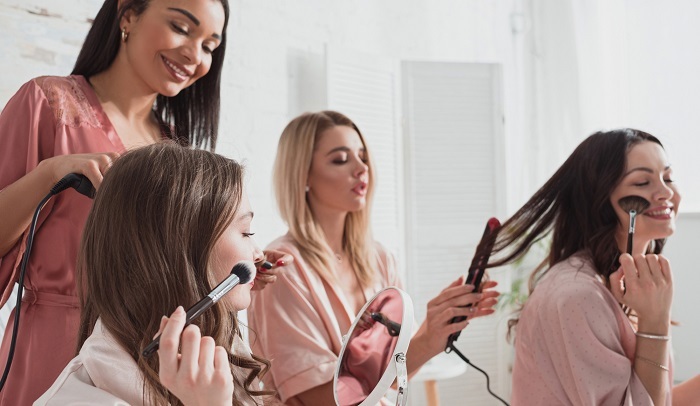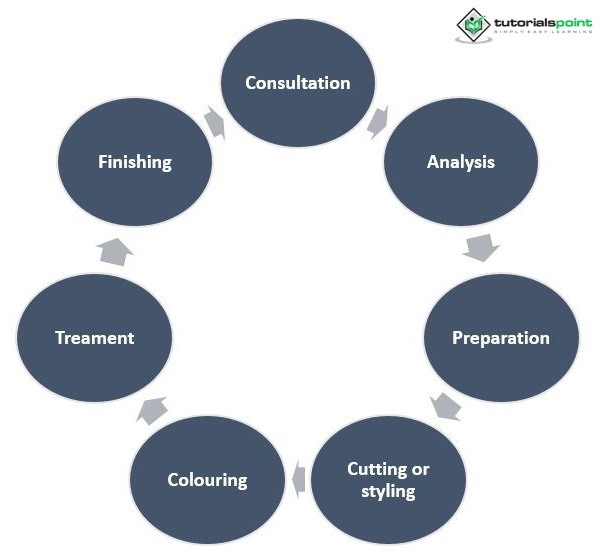

Hairdressing is the art of styling, cutting, coloring, and treating hair to create a desired look. It's a skilled profession that requires knowledge of various techniques, tools, and products, as well as an eye for design and a dedication to customer service. Hairdressers work with a range of clients, from everyday customers to celebrities, and can specialize in a particular area, such as cutting or coloring.

The hairdresser will then analyze the client's hair to determine its texture, porosity, elasticity, and other characteristics that will impact the chosen techniques and products.
Depending on the service, the hairdresser will then prepare the hair by shampooing, conditioning, and detangling it. They may also apply protective products to the hair and skin.
If the service involves cutting or styling the hair, the hairdresser will use appropriate tools, such as scissors or a curling iron, to create the desired look.

Here is a step-by-step explanation of the hairdressing process −
The first step is to consult with the client to determine their desired outcome. This includes discussing their hair type, face shape, lifestyle, and any concerns they may have.
If the service involves coloring the hair, the hairdresser will mix the chosen color and apply it to the hair using appropriate techniques, such as balayage or foiling. They will then allow the colour to process for the appropriate amount of time before rinsing it out.
After coloring, the hairdresser may apply a treatment, such as a mask or serum, to help condition and protect the hair.
Finally, the hairdresser will finish the look by blow-drying, styling, and adding any finishing touches, such as hairspray or shine serum.
Throughout the process, the hairdresser will also communicate with the client to ensure they are comfortable and satisfied with the outcome.
Here are some common tools and products used in hairdressing −
Scissors: Scissors are used for cutting hair.
Clippers: It used for cutting and trimming hair, especially on men.
Razors: Razors are used for texturizing hair or creating specific styles.
Combs: used for detangling, sectioning, and styling hair.
Brushes: used for smoothing and styling hair, often with a blow dryer.
Curling iron: Curling irons are used to create curls and waves.
Flat iron: Flat irons are used for straightening hair.
Blow dryer: A blow dryer is used for drying and styling hair.
Diffuser: used with a blow dryer to create volume and texture.
Sectioning clips: Sectioning clips are used to hold sections of hair in place during cutting, styling, or coloring.
Shampoo: Shampoo is used for cleansing the hair and scalp.
Conditioner: Conditioner is used for moisturizing and detangling the hair.
Styling products: Styling products, such as mousse, gel, wax, and hairspray, are used to create and hold a specific style.
Coloring products: Coloring products, such as hair dye, bleach, and toner, are used to change the hair's color.
Treatments: Treatments, such as hair masks, serums, and oils, are used to nourish and repair the hair.
Heat protectant: Heat protectant used to protect the hair from damage when using hot tools.
Sanitation products: Sanitation products, such as disinfectant sprays and wipes, are used to maintain a clean and safe salon environment.
Here are some cutting techniques used in hairdressing −
Scissor over comb: This technique involves using scissors to cut the hair while combing it at the same time, creating a natural and blended look.
Razor cutting: This technique uses a razor blade to cut the hair, resulting in a softer and more textured look.
Point cutting: This technique involves using the tips of the scissors to create textured ends.
Layering: This technique involves cutting different lengths of hair to create volume and movement.
Graduation: This technique involves cutting the hair at an angle, creating a stacked effect that creates volume at the crown.
Here are some styling techniques used in hairdressing −
Blow-drying: This technique involves using a hair dryer and brush to dry and style the hair, creating volume and smoothness.
Curling: This technique involves using a curling iron or hot rollers to create curls and waves in the hair.
Straightening: This technique involves using a flat iron to straighten the hair, creating a smooth and sleek look.
Updos: This technique involves creating a hairstyle that is pinned or fastened at the back of the head, such as a bun or French twist.
Braiding: This technique involves weaving sections of hair together to create a variety of styles, such as French braids or fishtail braids.
Texturizing: This technique involves using products and tools to create texture in the hair, such as beach waves or a messy, tousled look.
Hair analysis is an important step in the hairdressing process, as it allows hairdressers to understand the unique characteristics of each client's hair and make informed decisions about which techniques and products to use. Here are some aspects of hair analysis that a hairdresser may consider −
Texture: The texture of hair can be fine, medium, or coarse and can impact how easily the hair can be styled or how well it holds a certain style.
Porosity: This refers to the hair's ability to absorb moisture and can be affected by damage or chemical treatments. Knowing the porosity of the hair can help a hairdresser choose the appropriate products for styling or coloring.
Elasticity: This refers to the hair's ability to stretch and return to its original state. Hair with good elasticity is healthy and can be styled easily.
Density: The density of hair refers to how many strands are present on the head. Hairdressers may need to adjust their cutting or styling techniques based on the density of the hair.
Scalp condition: A hairdresser may also examine the client's scalp for any signs of dryness, oiliness, or other conditions that may impact the health of the hair.
By analyzing these characteristics, a hairdresser can create a customized plan for cutting, styling, and coloring the hair that takes into account the unique needs and characteristics of each client's hair.
Coloring techniques are an important part of the hairdressing process, as they allow hairdressers to add depth, dimension, and vibrancy to their clients' hair. Here are some common coloring techniques used in hairdressing −
Highlights: This involves coloring small sections of hair to create lighter strands throughout the hair. This can be done using foils or freehand techniques like balayage or ombre.
Lowlights: This involves coloring small sections of hair to create darker strands throughout the hair, adding depth and dimension to the overall color.
Single-process color: This involves applying a single shade of hair colour all over the hair, either to enhance the natural colour or to create a new look.
Double-process color: This involves two steps: first, lightening the hair to create a blank canvas, and then applying a toner or colour to achieve the desired shade.
Balmain: This is a freehand colouring technique that involves painting the hair with lightener to create a natural-looking, sun-kissed effect.
Ombre: This is a coloring technique that involves gradually lightening the hair from the mid-lengths to the ends, creating a subtle gradient effect.
Color melting: This involves blending two or more colors together to create a seamless transition between shades.
Color blocking: This involves colouring different sections of the hair with contrasting shades to create a bold, edgy look.
Hairdressers may use a combination of these techniques to achieve the desired result, depending on the client's hair type, natural color, and style preferences. It's important to note that coloring can be a complex process and should be done by a trained professional to avoid damage to the hair.
The hairdressing process involves a wide range of techniques, tools, and products to create a variety of looks and styles. From cutting and styling to colouring and analyzing the hair, each step plays an important role in achieving the desired result. Hairdressers use their knowledge and skills to assess each client's hair type and needs and then choose the appropriate techniques and products to create a customized plan. It is important to approach hairdressing with care and attention to detail to ensure the health and beauty of the client's hair.